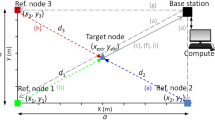Abstract
The location method based on Received Signal Strength Indication (RSSI) ranging has the advantages of low development cost and simple implementation mechanism, and is the mainstream indoor location method nowadays. However, at present, there is a lack of systematic research on the characteristics of Access Point (AP) received signal strength, which cannot meet the signal strength characteristics required by specific indoor positioning environment. Detailedly, in this study, the indoor distribution characteristics of 2.4 GHz RSSI were analyzed experimentally from three influencing factors including antenna orientation of the receiver, type of wireless network card of the receiver and height difference of the transmitting and receiving antenna. The experimental results show that: (1) The RSSI value measured is the strongest When the antenna of the receiver is vertically oriented to the antenna of the transmitter, while the antenna is vertically backward to the transmitter, it is the opposite. The difference between the strongest signal and the weakest signal is 20%–25% at the same test point. (2) The network card with a large measurement range should be selected for data collection on the premise that the quantization step size is 1 and the smoothness is small. Avoiding using the network card for positioning with the maximum limit of measurement range is proposed also. (3) The path loss index of the ranging model is affected by the height difference of the antenna, resulting in a deviation of 0.1–0.2.
This work was supported by the Natural Science Funds of China under Grant 61701213, the Cooperative Education Project of Ministry of Education under Grant 201702098015 and Grant 201702057020, the Special Research Fund for Higher Education of Fujian under Grant JK2017031, Zhangzhou Municipal Natural Science Foundation under Grant ZZ2018J21.
Access this chapter
Tax calculation will be finalised at checkout
Purchases are for personal use only
Similar content being viewed by others
References
Hossain, A.K.M.M., Soh, W.S.: A survey of calibration-free indoor positioning systems. Comput. Commun. 66, 1–13 (2015)
Al-Jazzar, S.O., Caffery, J., You, H.R.: A scattering model based approach to NLOS mitigation in TOA location systems. In: IEEE Vehicular Technology Conference (2002)
Keunecke, K., Scholl, G.: IEEE 802.11 n-based TDOA performance evaluation in an indoor multipath environment. In: European Conference on Antennas & Propagation. IEEE (2014)
Xie, Y., Wang, Y., Zhu, P., You, X.: Grid-search-based hybrid TOA/AOA location techniques for NLOS environments. IEEE Commun. Lett. 13(4), 254–256 (2009)
Halperin, D., Hu, W., Sheth, A., Wetherall, D.: Predictable 802.11 packet delivery from wireless channel measurements. Acm Sigcomm Comput. Commun. Rev. 40(4), 159–170 (2010)
Chen, Y.: Research on Wi-Fi indoor positioning technology based on rssi ranging. Master, Southwest University of Science and Technology (2015) (in Chinese)
Zeng, C., Liu, H.L., Xu, K., Han, W.J., Zhang, H.T.: RSSI characteristic analysis of indoor three-dimensional space positioning system. Comput. Eng. Appl. 50(11), 70–74 (2014). (in Chinese)
Zhang, H., Wang, X., Qu, X.D., Yang, J.: Analysis of propagation characteristics of wireless signals in indoor corridors. Comput. Eng. 44(10), 154–159+174 (2018). (in Chinese)
Hu, G.Q.: Study on propagation characteristics of indoor 5.8 GHz wireless signal. Comput. Digit. Eng. 45(8), 1611–1614 (2017). (in Chinese)
Kaemarungsi, K., Krishnamurthy, P.: Properties of indoor received signal strength for WLAN location fingerprinting. In: International Conference on Mobile & Ubiquitous Systems: Networking & Services, pp. 14–23. IEEE (2004)
Bahl, P., Padmanabhan, V.N.: RADAR: An in-building RF-based user location and tracking system. In: Nineteenth Annual Joint Conference of the IEEE Computer and Communications Societies, INFOCOM 2000, pp. 775C784. IEEE (2000)
Tsui, A.W., Chuang, Y.H., Chu, H.H.: Unsupervised learning for solving RSS hardware variance problem in wifi localization. Mobile Netw. Appl. 14(5), 677–691 (2009)
Kaemarungsi, K., Krishnamurthy, P.: Analysis of WLANs received signal strength indication for indoor location fingerprinting. Pervasive Mobile Comput. 8(2), 292–316 (2012)
Li, C.: Measurement and modeling of the influence of transceiver antenna height on wireless channel propagation characteristics. Master, Beijing University of Posts and Telecommunications (2015) (in Chinese)
Wang, Z.M.: Research on indoor positioning technology based on WLAN in airport waiting hall. Master, University of Electronic Science and Technology of China (2014) (in Chinese)
Chen, Y.L., Zhu, H.S., Sun, L.M.: A visual distance fingerprint location algorithm resistant to multipath and shadows. Comput. Res. Dev. 50(03), 524–531 (2013). (in Chinese)
Borel, C.C.: Surface emissivity and temperature retrieval for a hyperspectral sensor. In: IEEE International Geoscience & Remote Sensing Symposium. IEEE (1998)
Author information
Authors and Affiliations
Corresponding author
Editor information
Editors and Affiliations
Rights and permissions
Copyright information
© 2019 Springer Nature Switzerland AG
About this paper
Cite this paper
Lin, M., Wei, Z., Chen, B., Zhang, W., Yang, J. (2019). Analysis of WLAN’s Receiving Signal Strength Indication for Indoor Positioning. In: Cui, Z., Pan, J., Zhang, S., Xiao, L., Yang, J. (eds) Intelligence Science and Big Data Engineering. Big Data and Machine Learning. IScIDE 2019. Lecture Notes in Computer Science(), vol 11936. Springer, Cham. https://doi.org/10.1007/978-3-030-36204-1_1
Download citation
DOI: https://doi.org/10.1007/978-3-030-36204-1_1
Published:
Publisher Name: Springer, Cham
Print ISBN: 978-3-030-36203-4
Online ISBN: 978-3-030-36204-1
eBook Packages: Computer ScienceComputer Science (R0)




